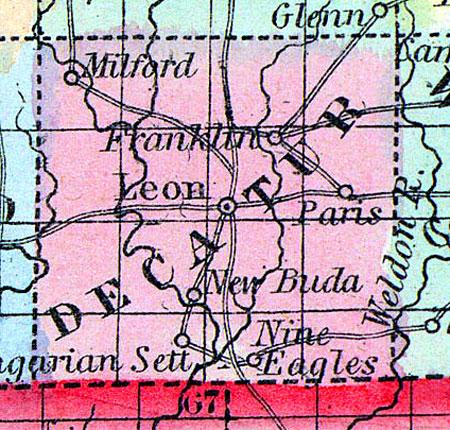DECATUR, a county in the S. part of Iowa, bordering on Missouri, has an area of 528 square miles. It is traversed from N. to S. by the Weldon river, and by the Crooked fork of Grand river. The surface is undulating; the soil fertile. The prairies of this county are separated by numerous groves of hard timber distributed along the watercourses. Indian corn, oats, grass, and pork are the staples. In 1850 this county produced 83,420 bushels of Indian corn; 4040 of oats; 1415 pounds of wool, and 8246 pounds of butter. A company of Hungarian refugees, about 300 in number, under Governor Ujhazy, have formed a settlement in this county, at New Buda. County seat not yet located. Population, 965. (Baldwin's New and Complete Gazetteer of the United States..., 1854)
DECATUR COUNTY Was first settled by some seven or eight families, who immigrated from Missouri, and located upon the then disputed territory between Missouri and Iowa, anticipating an extensive trade with the Indians, who at that time were quite numerous here. This was the only settlement in the county until 1846, when a company of Mormons settled near the N.E. corner of the county, calling their village Garden Grove. But few immigrants located in this county, however, before 1850, since when the increase has been rapid, and of the best of citizens. The population of Decatur County is 4020. The several denominations, Presbyterians, Methodists, Baptists and Christians, have each organizations, and have meetings in turn in the Court House in Leon, which is a respectable-sized two-story brick building. No buildings for public worship yet erected. No newspaper in Decatur or any adjoining county. In the county are some twenty-five public schools, well conducted, supported principally by the school fund. In the county are three steam, saw, and grist mills, and two others in process of erection. Those who may wish to locate, will find in Decatur good openings for saw and grist mills, brick-makers, wheelwrights, cabinet-makers, wagon-makers, house-builders, blacksmiths, tinners, and shoemakers. The northern part of the county is principally prairies, while the southern is supplied with a large and beautiful growth of timber. Though the county is more broken than many north and east of it, the soil is all susceptible of cultivation, and more than half the county heavily timbered. Thompson's Fork of Grand River and tributaries spreads over the western part of the county, affording an abundance of clear, soft water, and plenty of timber, for all purposes. These streams are backed by extensive beds of lime and sand-stone, suitable for building purposes, and supply water sufficient to run flouring or saw-mills, the year through. Wildou's Fork of Grand River, traversing the eastern portion of the county, is better timbered, but not so good a mill stream. Along the banks of several of these streams thin veins of coal have been discovered, and it is thought that extensive beds would be found by proper search, but no labor has yet been expended upon them. (Iowa as it is in 1855..., 1855)

